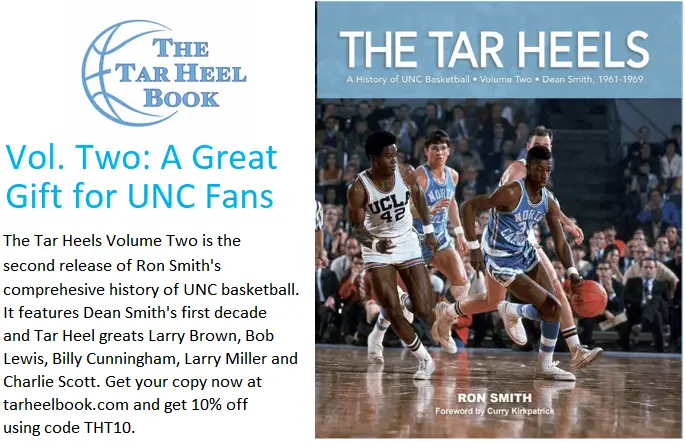By R.L. Bynum
BLOOMINGTON, Ind. — While the outcome of the games left much to be desired for North Carolina, it was interesting to experience gamedays at another school with a rich basketball tradition.
Assembly Hall is one of several remaining classic college basketball venues that hasn’t been cast aside in favor of bigger arenas. The facility remains where Bobby Knight turned Indiana into a national power and famously threw a chair in disgust — along with UCLA’s Pauley Pavilion, Kansas’ Allen Fieldhouse and Duke’s Cameron Indoor Stadium, to name a few.
Many schools no longer use their storied venues, with some refurbishing the arenas for women’s basketball, such as UNC’s Carmichael Arena and N.C. State’s Reynolds Coliseum. Assembly Hall is a larger version of those venerable arenas (seating more than 17,000), and has much of the same tradition.
I rarely go out of state for regular-season games. The lure of Assembly Hall and being able to cover Coach Hubert Davis’ men’s team and Coach Courtney Banghart’s women’s team against the Hoosiers on successive nights was too tempting to pass up. The least said about the games — the 77–64 men’s loss for their third consecutive defeat and the 87–63 women’s setback for their first loss — the better.
During the Hoosiers’ men’s victory Wednesday, the crowd generated noise at a volume that reminded me of the typical levels when men’s teams played before packed houses with sweltering temperatures in Carmichael and Reynolds. But, of course, it probably helped that the Indiana fans circled the game as soon as the schedule came out.
On a blustery evening for a late game, the line of IU students waiting was comparable to the lines of UNC students waiting before Duke games.
The Smith Center sometimes reaches high decibel levels against Duke and other opponents, but those sorts of ear-splitting moments comparable to Wednesday night at Assembly Hall aren’t as common.
The cavernous arena looks like a theater on each side of the court, with the rows rising steeply high up the arena, and there are dozens of upper-level rows. There aren’t many seats behind each baseline, and the walls behind those stands reverberate and amplify the sound.
Younger fans won’t remember the days before elaborate videos and music preceded the introduction of the starting lineups. But fans couldn’t hear the PA announcer give the names of the Tar Heels’ starters before games at Carmichael Auditorium (really, why was the name changed?) because of the sort of deafening noise I heard at Assembly Hall.

You get a sense of history before you enter the arena from the south side, with shrines in front of the building to each of Indiana’s five men’s national championships. That 1976 NCAA championship team included Scott May, the father of Sean May, a UNC assistant coach who was the most outstanding player on UNC’s 2005 national championship team.
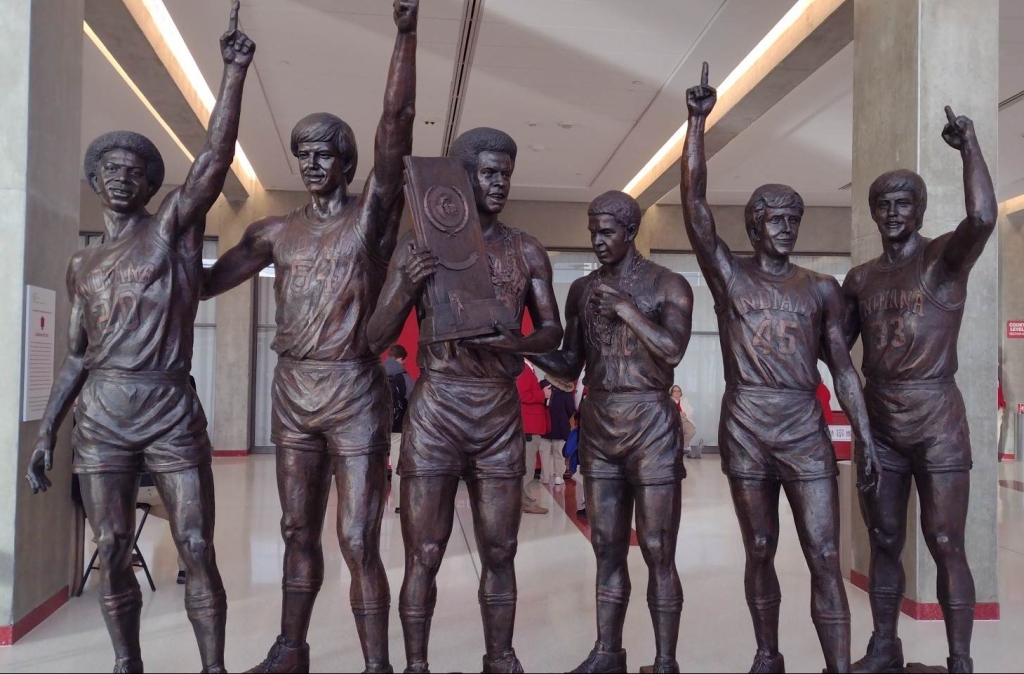
Once in the south-side concourse, there are statues of Indiana greats and more shrines to the Hoosiers’ national championship teams.

On the wall of the north-side concourse hangs a large section of the Assembly Hall court used in the 1970s (which, incidentally, the NCAA used for the 1978 Final Four in St. Louis — look it up: Duke lost to Kentucky in the final).
Large NCAA championship banners hang from the wall on the south side. But there are only five, one fewer than hang from the Smith Center rafters.
One was earned against UNC in 1981, the last time that the Tar Heels lost in the national-championship game and were the preseason No. 1 team the following season. That 1981–82 team, with a freshman named Michael Jordan, won one of those six UNC titles.
In addition, while there’s a women’s basketball national championship banner from 1994 in Carmichael, there is no such banner at Assembly Hall.

Every school has its quirky traditions. At Indiana, it’s showing a video of the “Mop Lady” singing the IU fight song as she mops a hallway under the stands at Assembly Hall. The woman is Martha Webster, an older lady who portrayed a janitor in an ad campaign for an insurance company.
The above video, played before the games both nights, excited the Hoosiers fans. It’s not exactly “Jump Around,” but it works at Indiana games.
For men’s games, most of the media — including me — sit behind two rows of tables at the top of the lower arena on the east side. It’s not that much farther from the court than the upper-level press tables in the corner of the Smith Center.

The problem was that there was so much demand for tickets that some students were in an overflow section directly in front of the press tables. And they stood the entire time. So, I stood for the entire game rather than looking through small spaces between heads and arms or watching on one of the televisions.
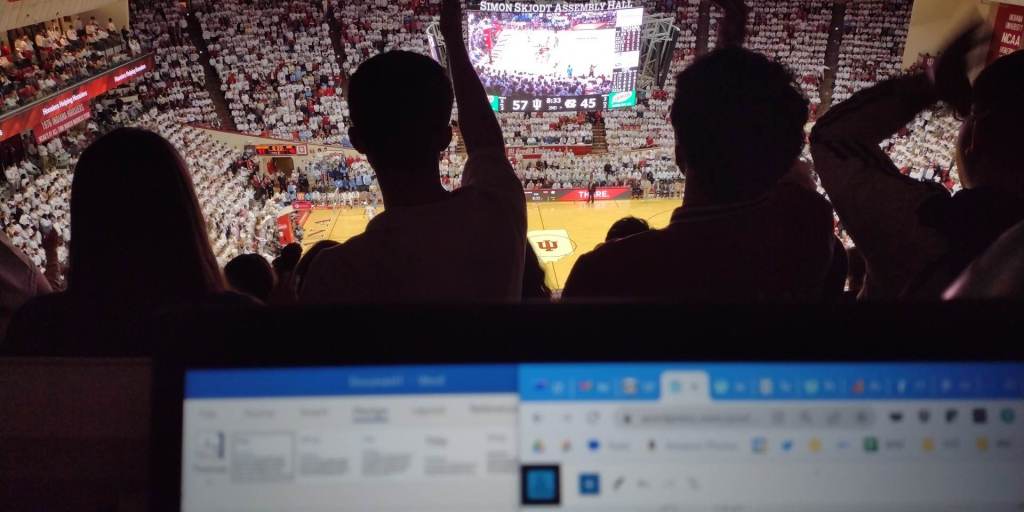
There was a little bit of the no-class student cheering that we’ve come to expect from the Cameron Crazies, including chants of “f you, Bacot” (only they didn’t say “f”) early in the game. The hostility toward Bacot was curious, considering that he had never faced the Hoosiers and IU wasn’t one of the final schools he considered.
A quick aside: Fans watching on TV have no idea what opposing players hear during Duke home games. I was covering a Duke-Florida State game in the 1990s when Heisman Trophy winner Charlie Ward was about to make an inbounds pass right in front of me. A male Duke student behind me loudly asked, in explicit terms, if Ward performed a certain sexual act on Coach Bobby Bowden. Ward didn’t flinch or look back. He clearly heard it, though.
Much like the common practice at Maryland during its time in the ACC, every IU student had a copy of the school’s student newspaper — the Indiana Daily Student — with a double-page poster reading, “HAMMER THE HEELS” waiting at their seats both nights.

Like at Cameron, the home-court advantage is immense. I’m sure the environment isn’t always like it was for the Carolina game, but it was absolutely electric. When the Hoosiers went on big runs, it reminded me of the adrenaline-inducing, raucous Carmichael crowds when I was a little kid and my parents — who both worked for the university — were season-ticket holders.
For a regular-season game not involving rivals, I’d be surprised if there are many atmospheres that are a lot better.
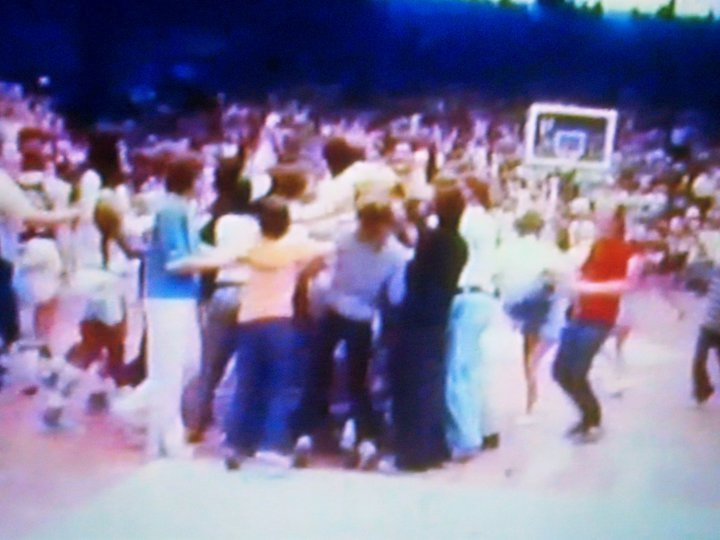
Another aside: When Walter Davis hit a 35-foot shot at the buzzer to send the 1974 Duke game into overtime, I was one of the excited kids who ran out on the court to pat “Sweet D” on the back. That’s me in the yellow Adidas shirt in the blurry screen image. His shot capped the historic rally from eight points down with 17 seconds left, and the Heels won in overtime.
I was sitting on the first-row aisle (next to Lillian Lee, the wife of former Chapel Hill mayor Howard Lee) behind Mitch Kupchak as he (as Woody Durham said on the call) made “the long front-court pass.” After Davis banked in the shot, I joined the mob that quickly surrounded Davis.
All of the childhood memories are why Carmichael is my favorite building of any kind in the world and why I treasure covering Carolina women’s basketball there.
The Smith Center is a terrific facility, but I miss the sellout men’s crowds at Carmichael that created the sort of atmosphere I witnessed at Assembly Hall.
On Thursday, the crowd, albeit smaller at 5,939, was just as lively, with the IU students razzing Kennedy Todd-Williams with chants of “air ball” every time she touched the ball after an errant shot. Somehow, those went away when she swished in a couple of 3-pointers.
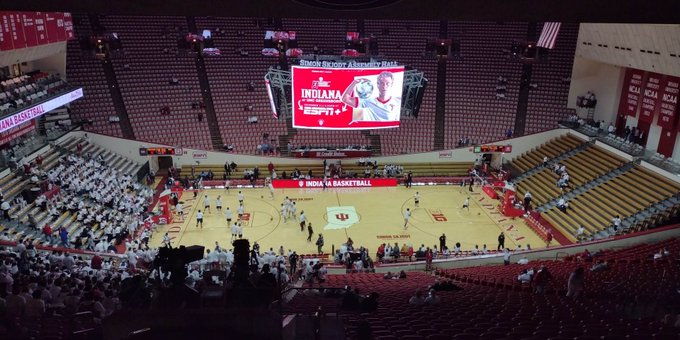
Thankfully, my vantage point was significantly better for the women’s game, at an elevated table about 10 feet behind the scorer’s table on the west side of the court. The Tar Heel Sports Network sat at that table both nights. It was nice to be able to sit for the entire game because I wasn’t dealing with hyped-up IU students constantly jumping up and down constantly.
What I saw for the second consecutive night was tough to watch, as it was to hear the late-game cheer of “just like last night.”
Regardless of the outcomes, it was special to see games at Assembly Hall.




